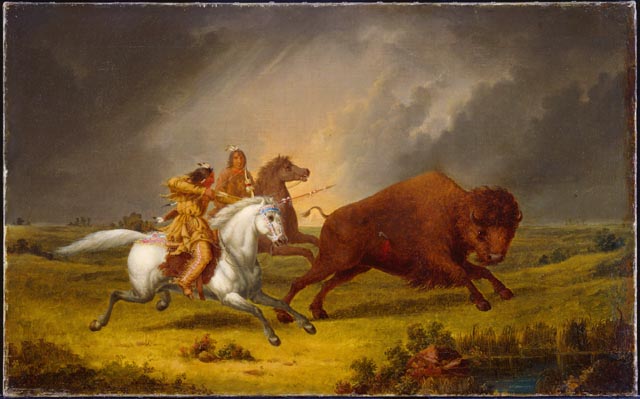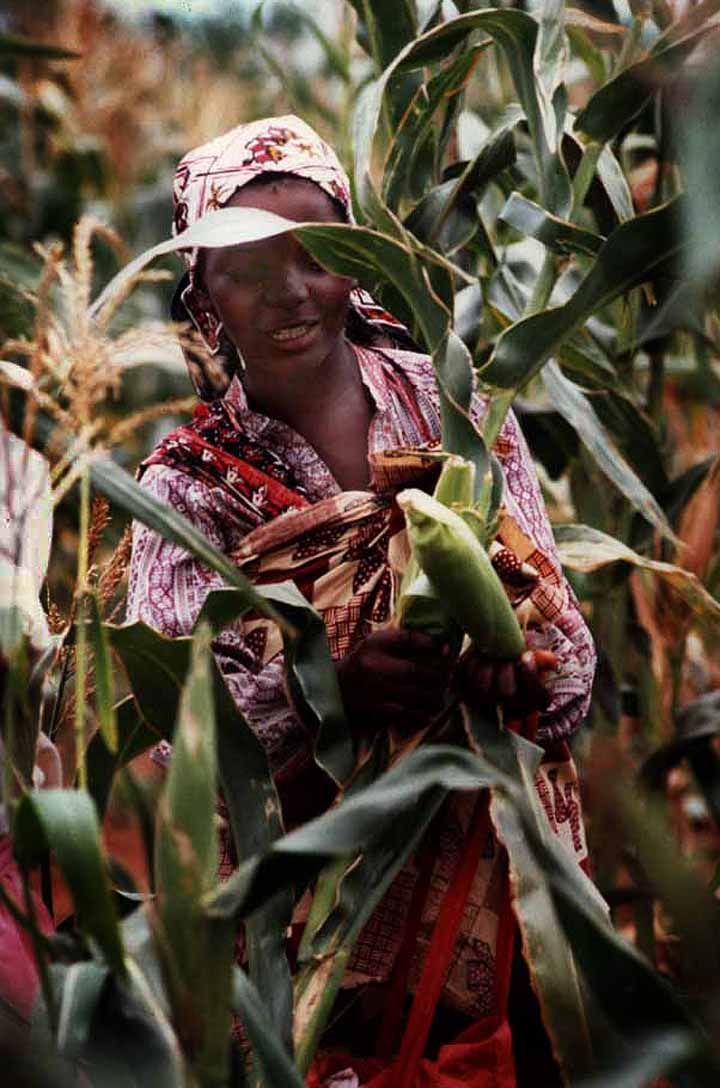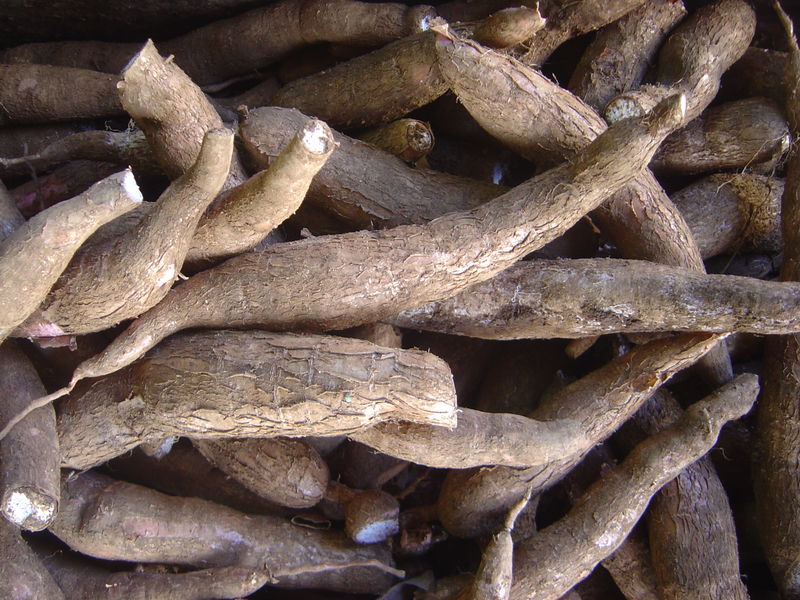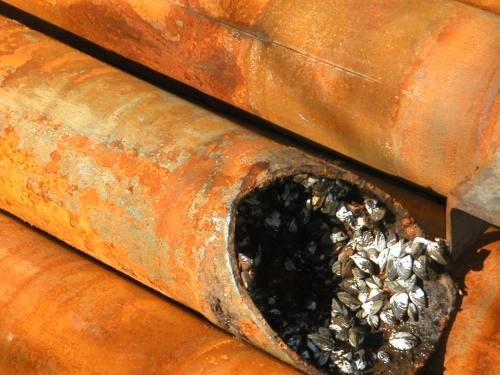What Animals And Plants Did Christopher Columbus Discover On The Water
When Christopher Columbus and his coiffure arrived in the New World, two biologically singled-out worlds were brought into contact. The animate being, plant, and bacterial life of these two worlds began to mix in a process called the Columbian Commutation. The results of this exchange recast the biology of both regions and altered the history of the world.
Geologists believe that between 280 million and 225 one thousand thousand years ago, the globe's previously dissever land areas became welded into a landmass called Pangaea. About 120 one thousand thousand years ago, they believe, this landmass began to separate. Every bit this happened, the Atlantic Ocean formed, dividing the Americas from Africa and Eurasia. Over the class of the side by side several one thousand thousand years in both the Americas and in Afro-Eurasia, biological development followed individual paths, creating two primarily separate biological worlds. All the same, when Christopher Columbus and his crew fabricated land in the Bahamas in October 1492, these two long-separated worlds were reunited. Columbus' voyage, along with the many voyages that followed, disrupted much of the biological segregation brought well-nigh past continental drift.
Later Columbus' arrival in the Americas, the animate being, institute, and bacterial life of these ii worlds began to mix. This process, showtime studied comprehensively past American historian Alfred Crosby, was called the Columbian Exchange. Past reuniting formerly biologically distinct state masses, the Columbian Exchange had dramatic and lasting effects on the earth. New diseases were introduced to American populations that had no prior experience of them. The results were devastating. These populations also were introduced to new weeds and pests, livestock, and pets. New food and cobweb crops were introduced to Eurasia and Africa, improving diets and fomenting merchandise there. In addition, the Columbian Exchange vastly expanded the scope of product of some popular drugs, bringing the pleasures — and consequences — of java, saccharide, and tobacco apply to many millions of people. The results of this exchange recast the biology of both regions and altered the history of the globe.
The period from east to west: Affliction
By far the most dramatic and devastating affect of the Columbian Exchange followed the introduction of new diseases into the Americas. When the kickoff inhabitants of the Americas arrived across the Bering state bridge betwixt 20,000 and 12,000 years ago, they brought few diseases with them. Why? For 1 reason, they had no domesticated animals, the original source of human diseases such as smallpox and measles. In add-on, every bit they passed from Siberia to North America, the first Americans had spent many years in extreme cold, which eliminated many of the illness-causing agents that might accept traveled with them. Every bit a result, the first Americans and their descendants, perhaps 40 million to 60 million strong past 1492, enjoyed liberty from most of the infectious diseases that plagued populations in Afro-Eurasia for millennia. Meanwhile, in Asia and Africa, the domestication of herd animals brought new diseases spread by cattle, sheep, pigs, and fowl.
Presently after 1492, sailors inadvertently introduced these diseases — including smallpox, measles, mumps, whooping cough, influenza, chicken pox, and typhus — to the Americas. People who lived in Afro-Eurasia had adult some immunities to these diseases because they had long existed among most Afro-Eurasian populations. However, the Native Americans had no such immunities. Adults and children alike were stricken by wave after wave of epidemic, which produced catastrophic bloodshed throughout the Americas. In the larger centers of highland Mexico and Peru, many millions of people died. On some Caribbean islands, the Native American population died out completely. In all, betwixt 1492 and 1650, possibly ninety percent of the first Americans had died.
This loss is considered among the largest demographic disasters in human history. Past stripping the Americas of much of the homo population, the Columbian Exchange rocked the region'due south ecological and economic remainder. Ecosystems were in tumult as forests regrew and previously hunted animals increased in number. Economically, the population subtract brought past the Columbian Exchange indirectly caused a desperate labor shortage throughout the Americas, which somewhen contributed to the establishment of African slavery on a vast scale in the Americas. By 1650, the slave merchandise had brought new diseases, such equally malaria and xanthous fever, which further plagued Native Americans.
The menstruum from east to west: Crops and animals

Eurasians sent much more illness westward. The introduction of new crops and domesticated animals to the Americas did near every bit much to upset the region's biological, economic, and social residual as the introduction of affliction had. Columbus had wanted to found new fields of plenty in the Americas. On his after voyages he brought many crops he hoped might flourish there. He and his followers brought the familiar food grains of Europe: wheat, barley, and rye. They also brought Mediterranean plantation crops such as sugar, bananas, and citrus fruits, which all had originated in South or Southeast Asia. At commencement, many of these crops fared poorly; merely eventually they all flourished. After 1640, sugar became the mainstay of the Caribbean and Brazilian economies, condign the foundation for some of the largest slave societies ever known. The production of rice and cotton wool, both imported in the Columbian Exchange, together with tobacco, formed the basis of slave lodge in the Usa. Wheat, which thrived in the temperate latitudes of North and South America and in the highlands of Mexico, somewhen became a key food ingather for tens of millions of people in the Americas. Indeed, past the tardily 20th century, wheat exports from Canada, the United States, and Argentine republic were feeding millions of people outside the Americas. Information technology is true that the spread of these crops drastically changed the economy of the Americas. However, these new crops supported the European settler societies and their African slave systems. The Native Americans preferred their own foods.
When it came to animals, however, the Native Americans borrowed eagerly from the Eurasian stables. The Columbian Substitution brought horses, cattle, sheep, goats, pigs, and a drove of other useful species to the Americas. Before Columbus, Native American societies in the loftier Andes had domesticated llamas and alpacas, but no other animals weighing more than than 45 kg (100 lbs). And for adept reason: none of the other 23 large mammal species present in the Americas before the arrival of Columbus were suitable for domestication. In contrast, Eurasia had 72 large animal species, of which 13 were suitable for domestication. And then, while Native Americans had plenty of skillful nutrient crops available before 1492, they had few domesticated animals. The main ones, bated from llamas and alpacas, were dogs, turkeys, and guinea pigs.

Of all the animals introduced by the Europeans, the horse held particular allure. Native Americans commencement encountered it every bit a fearsome war beast ridden past Spanish conquistadors. However, they presently learned to ride and raise horses themselves. In the North American corking plains, the arrival of the equus caballus revolutionized Native American life, permitting tribes to chase the buffalo far more effectively. Several Native American groups left farming to become buffalo-hunting nomads and, incidentally, the most formidable enemies of European expansion in the Americas.
Cattle, sheep, pigs, and goats also proved popular in the Americas. Within 100 years after Columbus, huge herds of wild cattle roamed many of the natural grasslands of the Americas. Wild cattle, and, to a bottom degree, sheep and goats, menaced the food crops of Native Americans, notably in Mexico. Somewhen ranching economies emerged, based variously on cattle, goats, or sheep. The largest ranches emerged in the grasslands of Venezuela and Argentina, and on the wide sea of grass that stretched from northern Mexico to the Canadian prairies. Native Americans used the livestock for meat, tallow, hides, transportation, and hauling. Altogether, the suite of domesticated animals from Eurasia brought a biological, economic, and social revolution to the Americas.
The flow from due west to east: Disease
In terms of diseases, the Columbian Exchange was a wildly unequal affair, and the Americas got the worst of information technology. The flow of illness from the Americas eastward into Eurasia and Africa was either piffling or consisted of a single important infection. Much less is known well-nigh pre-Columbian diseases in the Americas than what is known about those in Eurasia. Based on their study of skeletal remains, anthropologists believe that Native Americans certainly suffered from arthritis. They also had another disease, probably a class of tuberculosis that may or may not accept been similar to the pulmonary tuberculosis mutual in the modernistic world. Native Americans also apparently suffered from a grouping of illnesses that included two forms of syphilis. One controversial theory asserts that the crabs syphilis epidemic that swept much of Europe start in 1494 came from the Americas; however, the available bear witness remains inconclusive.
The flow from west to due east: Crops and cuisine

America'due south vast contribution to Afro-Eurasia in terms of new plant species and cuisine, however, transformed life in places equally far autonomously equally Ireland, South Africa, and China. Before Columbus, the Americas had plenty of domesticated plants. By the time Columbus had arrived, dozens of plants were in regular employ, the most important of which were maize (corn), potatoes, cassava, and various beans and squashes. Lesser crops included sweet murphy, papaya, pineapple, tomato, avocado, guava, peanuts, chili peppers, and cacao, the raw form of cocoa. Within 20 years of Columbus' final voyage, maize had established itself in North Africa and perhaps in Spain. It spread to Egypt, where it became a staple in the Nile Delta, and from there to the Ottoman Empire, especially the Balkans. Past 1800, maize was the major grain in large parts of what is now Romania and Serbia, and was also important in Hungary, Ukraine, Italia, and southern France. It was often used every bit animal feed, but people ate it besides, usually in a porridge or bread. Maize appeared in China in the 16th century and eventually supplied most i-10th of the grain supply there. In the 19th century it became an important crop in Bharat. Maize probably played its greatest role, however, in southern Africa. There maize arrived in the 16th century in the context of the slave trade. Southern African environmental atmospheric condition, across what is at present Angola, Zambia, Zimbabwe, Mozambique, and eastern South Africa, suited maize amply. Over the centuries, maize became the primary peasant food in much of southern Africa. In late 20th-century South Africa, for instance, maize grew in 2-thirds to 3-quarters of the region's cropland.
Despite maize'due south success, the humble potato probably had a stronger bear on in improving the food supply and in promoting population growth in Eurasia. The potato had little touch on in Africa, where weather condition did not conform it. But in northern Europe the potato thrived. It had the most pregnant effect on Republic of ireland, where it promoted a rapid population increase until a potato bane ravaged the crop in 1845, bringing widespread dearth to the area. After 1750, Scandinavia, the Depression Countries, Germany, Poland, and Russia also gradually accepted the potato, which helped drive a full general population explosion in Europe. This population explosion may have laid the foundation for world-shaking developments such as the Industrial Revolution and modernistic European imperialism. The murphy besides fed mountain populations around the globe, notably in Red china, where it encouraged settlement of mountainous regions.

While maize and potatoes had the greatest earth historical importance of the American crops, bottom crops made their marks as well. In Westward Africa, peanuts and cassava provided new foodstuffs. Cassava, a tropical shrub native to Brazil, has starchy roots that will grow in almost any soil. In the leached soils of Westward and Central Africa, cassava became an indispensable crop. Today some 200 million Africans rely on it as their main source of nutrition. Cacao and rubber, two other S American crops, became of import export items in Westward Africa in the 20th century. The sweetness potato, which was introduced into China in the 1560s, became Cathay'south third almost of import crop after rice and wheat. It proved a useful supplement to diets throughout the monsoon lands of Asia. Indeed, almost everywhere in the world, ane or some other American food crops caught on, complementing existing crops or, more rarely, replacing them. By the tardily 20th century, near one-third of the world'due south food supply came from plants outset cultivate in the Americas. The modern rise of population surely would accept been slower without them.
In contrast, the animals of the Americas have had very little impact on the rest of the world, unless one considers its earliest migrants. The camel and the equus caballus really originated in North America and migrated westward across the Bering country bridge to Asia, where they evolved into the forms familiar today. Past the time of the Columbian Exchange, these animals were long extinct in the Americas, and the bulk of America's domesticated animals would accept little more than than a tiny impact on Afro-Eurasia. I domesticated brute that did have an effect was the turkey. Wild animals of the Americas have done only a picayune better. Probably afterward the 19th century, North American muskrats and squirrels successfully colonized large areas of Europe. Deliberate introductions of American animals, such every bit raccoons fancied for their fur and imported to Germany in the 1920s, occasionally led to escapes and the institution of feral creature communities. However, no species introduced from the Americas revolutionized homo affairs or animal environmental anywhere in Afro-Eurasia. In terms of animal populations as with disease, the Americas contributed piffling that could flourish in the conditions of Europe, Africa, or Asia.
The Columbian Commutation in the modern world

As the late dates of the introduction of muskrats and raccoons to Europe suggest, the Columbian Exchange continues into the nowadays. Indeed, information technology will surely continue into the future as mod transportation continues the pattern begun by Columbus. Recently, for case, zebra mussels from the Black Sea, stowed away in the anchor water of ships, invaded North American waters. At that place they blocked the water intakes of factories, nuclear power plants, and municipal filtration plants throughout the Neat Lakes region. Just equally the arrival of Christopher Columbus's ships in America in the 15th century resulted in the worldwide exchange of disease, crops, and animals, the 20th-century practise of ships using water as ballast helped unite the formerly diverse flora and animal of the world's harbors and estuaries. Similarly, air transport allows the spread of insects and diseases that would non easily survive longer, slower trips. Modern transport carries on in the tradition of Columbus by promoting a homogenization of the world'south plants and animals. To engagement, nevertheless, the world historical importance of modern exchanges pales beside that which took place in the original Columbian Exchange.
Source: https://www.ncpedia.org/anchor/columbian-exchange
Posted by: keslercontold.blogspot.com

0 Response to "What Animals And Plants Did Christopher Columbus Discover On The Water"
Post a Comment